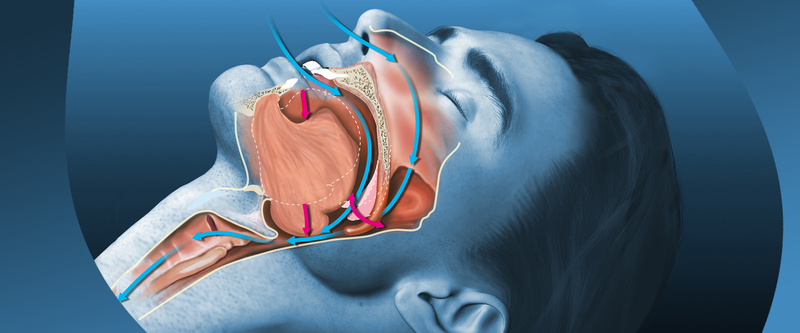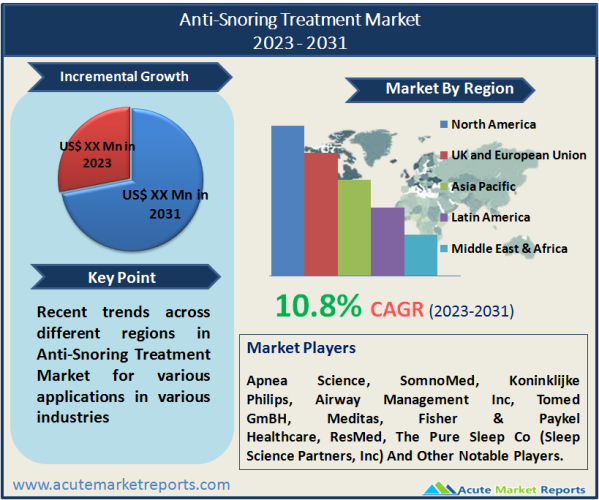
The anti-snoring treatment market is expected to grow at a CAGR of 10.8% during the forecast period of 2025 to 2033, driven by the increasing prevalence of snoring and the growing awareness of its health implications. Snoring is a common condition caused by the obstruction of airflow during sleep, resulting in loud and disruptive noises. It not only affects the quality of sleep for both the snorer and their bed partner but can also lead to various health issues such as daytime fatigue, cardiovascular problems, and decreased cognitive function. The global anti-snoring treatment market is expected to witness a significant increase in market revenue, with a notable compound annual growth rate (CAGR) over the forecast period.The rise in market revenue can be attributed to several factors. Firstly, the growing awareness about the health consequences of snoring has led to an increased demand for effective treatment options. People are more proactive in seeking solutions to alleviate their snoring problems, leading to the adoption of anti-snoring devices and therapies. Secondly, advancements in technology and product innovation have resulted in the development of a wide range of anti-snoring treatment options. These include mandibular advancement devices, tongue stabilizing devices, nasal devices, oral appliances, and surgical interventions. The availability of a diverse range of treatments catering to different snoring causes and preferences has contributed to market growth. Lastly, the rise in healthcare expenditure and the increasing focus on sleep disorders by healthcare providers have further propelled the demand for anti-snoring treatments.

Growing Awareness and Health Concerns
The increasing awareness about the health implications of snoring is a key driver for the anti-snoring treatment market. As people become more knowledgeable about the adverse effects of snoring on their health, there is a growing demand for effective treatment options. For instance, snoring has been associated with an increased risk of cardiovascular diseases, hypertension, and stroke. A study published in the journal Chest found that habitual snoring is an independent risk factor for the development of hypertension. This awareness has motivated individuals to seek anti-snoring treatments to improve their sleep quality and overall health.
Technological Advancements and Product Innovation
Technological advancements in the field of anti-snoring treatment have led to the development of innovative products and therapies. This driver includes the introduction of devices such as mandibular advancement devices (MADs) and tongue stabilizing devices (TSDs). MADs work by repositioning the lower jaw to open the airway, while TSDs aim to stabilize the tongue to prevent its collapse during sleep. These devices have gained popularity due to their effectiveness and ease of use. For example, a study published in the Journal of Clinical Sleep Medicine evaluated the efficacy of a specific MAD and found that it significantly reduced snoring and improved sleep quality.
Increasing Demand for Non-Invasive Treatment Options
Another driver of the anti-snoring treatment market is the rising demand for non-invasive treatment options. Many individuals prefer non-surgical and non-pharmacological approaches to address their snoring issues. This demand is driven by factors such as convenience, cost-effectiveness, and minimal side effects. As a result, devices like nasal dilators and nasal strips have gained traction in the market. These products work by opening the nasal passages, improving airflow, and reducing snoring. A study published in the journal Sleep and Breathing demonstrated the efficacy of nasal dilators in reducing snoring and improving sleep quality.
Lack of Treatment Compliance and Effectiveness
One major restraint in the anti-snoring treatment market is the issue of treatment compliance and effectiveness. While there are various treatment options available, including devices and therapies, the success rate and long-term effectiveness of these treatments can vary among individuals. Compliance with treatment regimens can be challenging, especially for devices such as oral appliances and nasal devices that need to be worn during sleep. Many individuals may find these devices uncomfortable or inconvenient, leading to low adherence and reduced treatment effectiveness. A study published in the journal Chest examined the compliance of patients using an oral appliance for snoring treatment and found that adherence decreased over time, with only a small percentage of patients using the device regularly after one year. Additionally, the effectiveness of certain anti-snoring treatments may vary based on the underlying causes of snoring. For example, if snoring is primarily caused by nasal congestion or allergies, nasal devices or dilators may be less effective compared to treatments targeting other factors such as tongue position or jaw alignment. These challenges in treatment compliance and effectiveness can limit the overall success and impact of anti-snoring treatments, posing a restraint to the market's growth and adoption.
The Nasal Devices Dominated the Revenues for Market by Devices
The anti-snoring treatment market is segmented into various device categories, including oral appliances, nasal devices, position control devices, chin straps, tongue-stabilizing devices, and expiratory positive airway pressure (EPAP) therapy devices. Among these segments, oral appliances are expected to have the highest CAGR during the forecast period of 2025 to 2033. Oral appliances, such as mandibular advancement devices (MADs), are commonly used to treat snoring by repositioning the lower jaw and opening the airway to improve airflow during sleep. These devices offer convenience and ease of use, contributing to their growing popularity among snorers. Additionally, oral appliances have shown promising results in reducing snoring and improving sleep quality, as indicated by a study published in the Journal of Clinical Sleep Medicine.In terms of highest revenue, the nasal devices segment dominated the market in 2024. Nasal devices, including nasal dilators and nasal strips, work by improving nasal airflow and reducing snoring caused by nasal congestion or collapse. These devices are non-invasive and provide immediate relief, making them a preferred choice for individuals seeking non-surgical treatment options. Furthermore, nasal dilators have been found to effectively reduce snoring intensity and improve sleep quality, as demonstrated in a study published in the journal Sleep and Breathing.
UPPP Dominates the Market by Surgical Procedures
The anti-snoring treatment market includes various surgical procedures aimed at addressing snoring and sleep-related breathing disorders. Among these segments, the surgery segment is expected to witness the highest CAGR during the forecast period of 2025 to 2033. Surgical interventions offer long-term solutions for snoring by addressing anatomical issues that contribute to airway obstruction.One of the surgical procedures with the highest CAGR is laser-assisted uvulopalatoplasty (LAUP). LAUP involves the use of a laser to remove or reshape excess tissues in the throat, including the uvula and soft palate, to increase the size of the airway and reduce snoring. The procedure has shown promising results in reducing snoring and improving sleep quality, as indicated by studies published in the Journal of Laryngology & Otology and the journal Chest.In terms of highest revenue, uvulopalatopharyngoplasty (UPPP) dominated the market in 2024. UPPP involves the surgical removal or repositioning of excess tissues in the throat, including the uvula, tonsils, and parts of the soft palate, to widen the airway and reduce snoring. It is considered a standard surgical procedure for snoring and sleep apnea. The effectiveness of UPPP in reducing snoring has been demonstrated in multiple studies, including a systematic review published in the American Journal of Respiratory and Critical Care Medicine.
Historical & Forecast Period
This study report represents analysis of each segment from 2023 to 2033 considering 2024 as the base year. Compounded Annual Growth Rate (CAGR) for each of the respective segments estimated for the forecast period of 2025 to 2033.
The current report comprises of quantitative market estimations for each micro market for every geographical region and qualitative market analysis such as micro and macro environment analysis, market trends, competitive intelligence, segment analysis, porters five force model, top winning strategies, top investment markets, emerging trends and technological analysis, case studies, strategic conclusions and recommendations and other key market insights.
Research Methodology
The complete research study was conducted in three phases, namely: secondary research, primary research, and expert panel review. key data point that enables the estimation of Anti-Snoring Treatment market are as follows:
Market forecast was performed through proprietary software that analyzes various qualitative and quantitative factors. Growth rate and CAGR were estimated through intensive secondary and primary research. Data triangulation across various data points provides accuracy across various analyzed market segments in the report. Application of both top down and bottom-up approach for validation of market estimation assures logical, methodical and mathematical consistency of the quantitative data.
| ATTRIBUTE | DETAILS |
|---|---|
| Research Period | 2023-2033 |
| Base Year | 2024 |
| Forecast Period | 2025-2033 |
| Historical Year | 2023 |
| Unit | USD Million |
| Segmentation | |
Device
| |
Type
| |
Distribution Channel
| |
|
Region Segment (2023-2033; US$ Million)
|
Key questions answered in this report